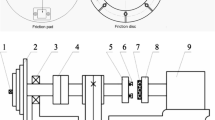Abstract
Three different C/C composites with rough laminar (RL) pyrocarbon, RL pyrocarbon with added resin-derived carbon, and pure resin-derived carbon have been evaluated and tested for friction performance. A laboratory dynamometer was used to simulate different braking speeds utilizing a single stator and rotor pair. The morphologies and microstructures of the raw materials, wear surfaces, and wear debris at different braking levels were observed by polarized light microscopy, scanning electron microscopy, and transmission electron microscopy. The results have shown that the friction coefficients of the three C/C composites display the same characteristics with increasing braking speed. They increased to a maximum value at medium braking speed and thereafter decreased with increasing braking speed, and their mean values under the same braking conditions were similar. The C/C composite with pure resin-derived carbon showed the highest loss due to wear under all conditions, while the C/C composite with the RL pyrocarbon showed the lowest loss. Resin-derived carbon in C/C composites does not have a significant effect on the friction coefficient, but the wear rate increases greatly with increasing resin-derived carbon content. Wear debris is composed of flocculent particles with polycrystalline structure, along with the matrix carbon, which is worn off directly from the composites.








Similar content being viewed by others
References
Hutton, T.J., McEnaney, B., Crelling, J.C.: Structural studies of wear debris from carbon–carbon composite aircraft brakes. Carbon 37, 907–916 (1999)
Bourrat, X., Trouvat, B., Limousin, G., Vignoles, G., Doux, F.: Pyrocarbon anisotropy as measured by electron diffraction and polarized light. J. Mater. Res. 15, 92–101 (2000)
Kasem, H., Bonnamy, S., Rousseau, B., Estrade-Szwarckopf, H., Berthier, Y., Jacquemard, P.: Interdependence between wear process, size of detached particles and CO2 production during carbon/carbon composite friction. Wear 263, 1220–1229 (2007)
De Pauw, V., Kalhhofer, S., Gerthsen, D.: Influence of the deposition parameters on the texture of pyrolytic carbon layers deposited on planar substrates. Carbon 42, 279–286 (2004)
Awasthi, S., Wood, J.L.: Carbon–carbon composite materials for aircraft brakes. Adv. Ceram. Mater. 3, 449–451 (1988)
Chen, J.D., Ju, C.P.: Friction and wear of PAN/pitch-, PAN/CVI- and pitch/resin/CVI-based carbon/carbon composites. Wear 174, 129–135 (1994)
Lee, K.J., Cheng, H.Z., Chen, J.S.: Effect of densification cycles on continuous friction behavior of carbon–carbon composites. Wear 260, 99–108 (2006)
Chen, J.D., Chern Lin, J.H., Ju, C.P.: Effect of load on tribological behaviour of carbon–carbon composites. J. Mater. Sci. 31, 1221–1229 (1996)
Yen, B.K., Ishihara, T.: On temperature-dependent tribological regimes and oxidation of carbon–carbon composites up to 1800°C. Wear 196, 254–262 (1996)
Rietsch, J.C., Dentzer, J., Dufour, A., Schnell, F., Vidal, L., Jacquemard, P., Gadiou, R., Vix-Guterl, C.: Characterizations of C/C composites and wear debris after heavy braking demands. Carbon 47, 83–95 (2009)
Sarkar, S., Badisch, E., Mitra, R., Manish Roy, : Impact abrasive wear response of carbon/carbon composites at elevated temperatures. Tribol. Lett. 37, 445–451 (2010)
Xiong, X., Huang, B.Y., Li, J.H., Xu, H.J.: Friction behaviors of carbon/carbon composites with different pyrolytic carbon textures. Carbon 44, 463–467 (2006)
Kim, D.G., Kweon, D.W., Lee, J.Y.: Wear properties of C/C composites prepared by chemical vapor deposition. J. Mater. Sci. Lett. 12, 8–10 (1993)
Ozcan, S., Filip, P.: Microstructure and wear mechanisms in C/C composites. Wear 259, 642–650 (2005)
Dupel, P., Bourrat, X., Pailler, R.: Structure of pyrocarbon infiltrated by pulse-CVI. Carbon 33, 1193–1204 (1995)
Tanabe, Y., Yasuda, E., Kimura, S.: Microstructural development of furan resin derived carbon by hot-pressing. In: 18th Biennial Conference on Carbon, Worcester, USA, pp. 241–242 (1987)
Kasem, H., Bonnamy, S., Berthier, Y., Dufrénoy, P., Jacquemard, P.: Tribological, physicochemical and thermal study of the abrupt friction transition during carbon/carbon composite friction. Wear 267, 846–852 (2009)
Lee, K.J., Tsai, M.J., Cheng, H.Z.: Effect of densification parameters on the low-energy tribological behavior of carbon/carbon composites. Carbon 48, 1353–1361 (2010)
Acknowledgment
This research was supported by the National Basic Research Program of China under Contract Number 2006CB600906.
Author information
Authors and Affiliations
Corresponding author
Rights and permissions
About this article
Cite this article
Lei, Bl., Yi, Mz., Xu, Hj. et al. Effect of Resin-Derived Carbon on the Friction Behavior of Carbon/Carbon Composites. Tribol Lett 41, 371–378 (2011). https://doi.org/10.1007/s11249-010-9723-0
Received:
Accepted:
Published:
Issue Date:
DOI: https://doi.org/10.1007/s11249-010-9723-0




